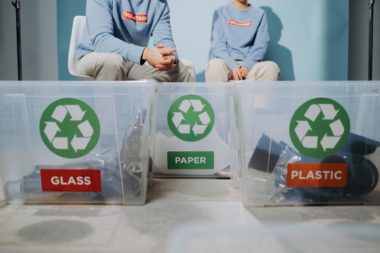Have you decided that it is time for your company to renew its focus on environmentally friendly manufacturing? Sustainability efforts have been on the radar for many companies for a long time, and small gains have been made over the past decade. At Rohrer, we noticed that brands have expedited their sustainability initiatives faster than ever before. A variety of reasons are prompting the changes: the anticipated emergence of Extended Producer Responsibility guidelines, consumer pressures, retailer requirements, and general corporate citizenship. Our team has seen a marked trend towards vigorous and significant changes in material selection. We are eager to partner with brands as they adopt new, sustainable packaging solutions.
Extended Producer Responsibility:
Most countries in the European Union have enacted Extended Producer Responsibility (EPR) guidelines or laws. These policies require manufacturers to pay for any pollution that may be a result of their manufacturing. “These laws, called extended producer responsibility (EPR) for packaging bills, shift those costs from consumers and cities to the companies selling the products in the first place” (Semuels, para. 5). Troy Moon, Portland’s sustainability coordinator, says, “Without EPR, there’s no incentive for manufacturers to reduce the amount of recycling…If they have skin in the game, they are apt to take it more seriously” (Semuels, para. 21). American activists and politicians have discussed EPR restrictions for years, but until recently they have not been implemented anywhere in the United States. Earlier this summer, both Maine and Oregon implemented their own extended producer responsibility laws for packaging. Maine’s law applies fees that producers must pay based on the weight of packaging, regardless of the recyclability of the packaging materials. Oregon’s law is similar to Maine’s but has been described as more inclusive of packaging industry stakeholders (Felton, 2021).
The Product Stewardship Institute further defines how EPR programs can provide solutions to the world’s trash crisis. EPR programs charge packaging companies and brand owners, which inevitably will pass costs to consumers. The right EPR programs could help fund local recycling programs which would reduce the costs of recycled materials. EPR programs could also provide incentives or rewards to packaging companies and brands that increase sustainability initiatives with improved manufacturing. “These companies decide what packaging to put on the market in the first place. Well-designed EPR programs require modulated fees that oblige producers, through financial incentives, to design their PPP to be recyclable, conserve materials, and incorporate recycled content into new PPP” (Product Stewardship Institute, para. 5).
Encouraging US-based recycling programs is more important than ever. Until recently, most of the United States recycling – as well as materials from nearly half of the world – went to recycling facilities in China. However, in 2018, China enacted a “National Sword” policy that banned the import of most plastics or other materials meant to be recycled (Katz, para. 1). China discontinued imports of recyclable materials because most of what they received was not actually recyclable. The contaminated materials compounded China’s trash problems. At the same time, many local municipalities in the US have ceased or reduced their local recycling programs. Some cities have discontinued curbside pick-up while others have severely restricted what they allow for recycling (The Enterprise Ledger, 2018; and Katz, para. 15). As a result, items that should have been recycled end up in landfills or incinerators.
Cities can sell bailed recycling if there is a market demand for recycled materials. Manufacturers can make a positive impact by developing ways to incorporate recycled materials into products and packaging, thus creating demand for recycled materials. Virgin materials are usually less expensive than recycled materials. A shift in demand helps to close the gap between the costs of virgin and recycled materials. Brands can cash in while doing the right thing – whether the United States implements national EPR programs or not.
Brands and Consumer Pressures:
 Retailers like Walmart and Amazon are changing packaging requirements, and states have begun implementing EPR laws and guidelines. Now, look to consumers. Consumers put pressure on manufacturers to incorporate recycled solutions in their processes.
Retailers like Walmart and Amazon are changing packaging requirements, and states have begun implementing EPR laws and guidelines. Now, look to consumers. Consumers put pressure on manufacturers to incorporate recycled solutions in their processes.
● Futerra, a London-based sustainability consultancy, asked 1,000 consumers in the USA and UK, “Would you like brands to help you be more environmentally friendly and ethical in your daily life?” 88% of respondents said they do want brands to help them live sustainably (Townsend, graphic 3).
● Consumers are willing to put their money where their mouth is, too. Accenture surveyed 6,000 consumers in 11 countries in North America, Europe, and Asia. The study showed that more than half of consumers would pay more for sustainable products (Accenture, 2015).
● First Insight published a report that these consumer trends span most generations. Willingness to pay more for sustainable products as follows: Gen Z – 73%; Millennials – 68%; Gen X – 55%; Silent Generation – 50%; and Baby Boomers – 42% (Berthiaume, 2020).
● NYU’s Stern’s Center for Sustainable Business published results of their consumer study in Harvard Business Review. Their research from 2013 to 2018 included more than 71,000 SKUs. The data showed that “products marketed as sustainable grew 5.6 times faster than those that were not” (Whelan and Kronthal-Sacco, para. 2).
Americans have an increasing hunger to purchase from brands that make sustainable manufacturing decisions. A study published by Nielsen concludes, “Consumers could note if they were willing to pay “a little” or “a lot” for each sustainability benefit. The top attributes that more than one-third of consumers were willing to pay more for included: cruelty-free (31%), farm-raised (32%), organic farming (33%) and environmentally friendly (33.5%)” (Wilson, para. 6). This knowledge and consumer pressure have caused many legacy brands and manufacturers to implement environmental goals, many of which include achievement by 2025. These are broad goals that reach every aspect of the manufacturing process.
In response to consumer pressures, brands look for ways to innovate and do more. Last year, P&G changed the packaging on a line of deodorants, replacing the plastic applicator with a recycled paperboard tube. Detergent brands have moved from bulky bottles to pods, at least as one offering, reducing shipping weight by eliminating water in the products. Adidas started designing shoes and clothing manufactured from ocean plastics in 2015. New products across all industries are launching with sustainable models. You may see laundry detergent sheets shipped in biodegradable envelopes, bars of shampoo wrapped in waxed paper (eliminating the plastic bottle), toothbrushes and hardwood floors made from fast-growing, renewable bamboo, etc.
Packaging Solutions:
The packaging industry has an opportunity to create lasting change, improving our environmental impact. One long-time trend in product packaging is through “design for sustainability.” This is achieve by “light-weighting,” reducing the materials used in a product’s package (ex. smaller cards, a reduced flange on blister packaging, fewer parts), or designing a package for long-term storage (ex. light bulbs and cotton swabs). In addition to reducing materials, brands can revisit their packaging materials selection.
Rohrer designs and manufactures a wide array of retail packaging solutions, but our primary packaging product line is ezCombo®. This is the trade name for Rohrer’s blister packaging made in a combo run. In the ezCombo® programs, Rohrer groups together orders with complimentary product sizes and matching paper or plastic gauge (thickness), packaging substrate, and quantities. The packaging runs together in what some industry professionals call a gang-run. Grouping together a variety of packages in the same printing and thermoforming runs reduces costs for all the brands because they share set-up expenses. It also allows Rohrer to be most efficient in providing low quantities.
In 2020, we reached a major milestone. Working with a variety of paper and plastic suppliers, we started to build a new program under the ezCombo® umbrella. Our goal was to create a new solution comprised of post-consumer recycled materials while maintaining a similar cost basis. We worked with our suppliers to find paper stock and plastic materials to test in the program. In both cases, we tested various levels of post-consumer recycled content (ex. PCR-PET at 25%, 50%, and 100% post-consumer waste). The operations team tested the board for printing vibrancy and fiber tear. They tested the plastic for forming, corner strength, and clarity. That is how we launched ecoCombo® which is part of the ezCombo® program. We rolled out the program with price parity for existing ezCombo® programs. This eliminates the biggest hurdle in changing brand behaviors – price. We added two additional features to the ecoCombo® program. We designed a “Sustainable Packaging” seal for all partners who used the new packaging program. This is a small identifier that brands can use to demonstrate a commitment to sustainability through their packaging. We also launched a partnership with One Tree Planted, and Rohrer plants a tree with every ecoCombo® purchase order.
This fall, Rohrer will offer the All-Paper Blister, our newest sustainable packaging solution and part of our ezCombo® program. Rohrer developed our All-Paper Blister solutions in partnership with several prominent OEM manufacturers. We designed and tested a variety of structures to ensure efficiency on these machines to reduce the impact on brands’ speed-to-market. As members of the Sustainable Packaging Coalition®, we followed the How2Recycle process with our All-Paper Blister packaging, too.
A McKinsey study noted that “almost all the top 100 FMCG companies (in terms of revenue) have made bold declarations and commitments to drive sustainability over the coming years” (Berg et al, para. 12). When it comes to making sustainable packaging decisions, cost and risk were always the prohibitive factors. Now brands must answer a new question. “What’s the cost of doing nothing?”
To explore Rohrer’s environmental statement, visit our sustainability page.
References:
Berthiaume, D. (2020, January 20) “Survey: Generations Differ on Importance of Sustainability” Chain Store Age. Retrieved from: https://chainstoreage.com/survey-generations-differ-importance-sustainability
Berg, P., Feber, D., Granskog, A., Nordigarden, D., & Ponkshe, S. (2020, January 30) “The drive toward sustainability in packaging—beyond the quick wins” McKinsey. Retrieved from: https://www.mckinsey.com/industries/paper-forest-products-and-packaging/our-insights/the-drive-toward-sustainability-in-packaging-beyond-the-quick-wins#
“City to kill curbside recycling pick-up” (2018, August 9) The Enterprise Ledger. Retrieved from https://dothaneagle.com/community/enterprise-ledger/city-to-kill-curbside-recycling-pick-up/article_355aaaba-9b3a-11e8-a449-2b8377a80d0a.html
Felton, D. (2021, August 9) “It Happened. Packaging Producer Responsibility is Law in the US.” PackagingDigest.com. Retrieved from: https://www.packagingdigest.com/sustainability/it-happened-packaging-producer-responsibility-law-us
Katz, C. (2019, March 27) “Piling Up: How China’s Ban on Importing Waste Has Stalled Global Recycling.” Yale.edu. Retrieved from: https://e360.yale.edu/features/piling-up-how-chinas-ban-on-importing-waste-has-stalled-global-recycling
“More than Half of Consumers Would Pay More for Sustainable Products Designed to Be Reused or Recycled, Accenture Survey Finds” (2019, June 4) Accenture. Retrieved from: https://newsroom.accenture.com/news/more-than-half-of-consumers-would-pay-more-for-sustainable-products-designed-to-be-reused-or-recycled-accenture-survey-finds.htm
“Product Stewardship Institute” (2020) Product Stewardship Institute. Retrieved from: https://www.productstewardship.us/page/Packaging
Semuels, A. (2020, February 26) “To Fix America’s Broken Recycling System, States Want Companies to Foot the Bill” Time. Retrieved from https://time.com/5790656/fixing-recycling-in-america/
Townsend, S. (2018, November 21) “88% of Consumers Want You to Help Them Make a Difference.” Forbes. Retrieved from: https://www.forbes.com/sites/solitairetownsend/2018/11/21/consumers-want-you-to-help-them-make-a-difference/#dbca8fb69547
Whelan, T. & Kronthal-Sacco, R. (2019, June 26). “Research: Actually, Consumers Do Buy Sustainable Products” HBR. Retrieved from https://hbr.org/2019/06/research-actually-consumers-do-buy-sustainable-products
Wilson, J. (2019, July 11) “Brands Increase Trust – and Prices – through Sustainability.” Nielsen. Retrieved from: https://www.nielsen.com/us/en/insights/article/2019/brands-increase-trust-and-prices-through-sustainability/



